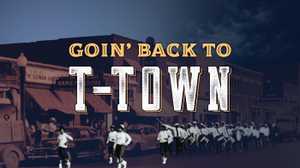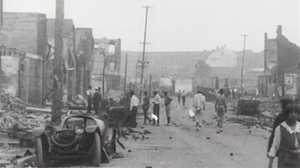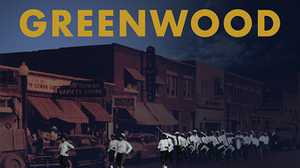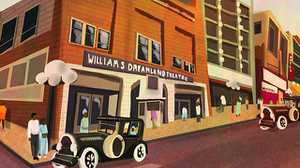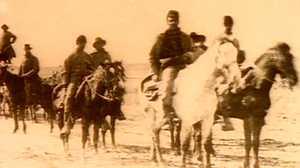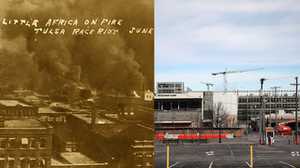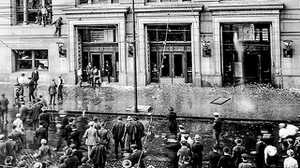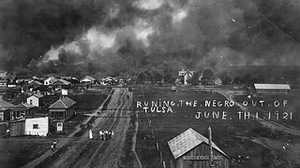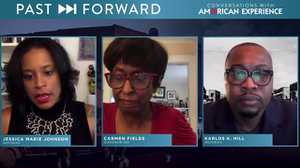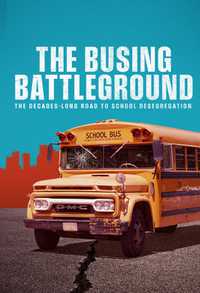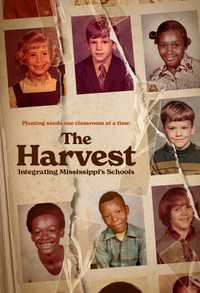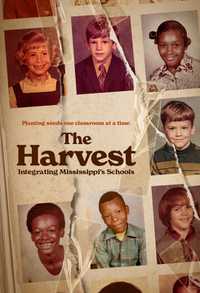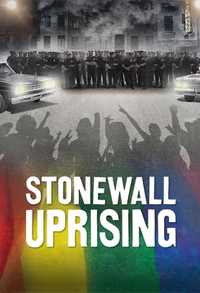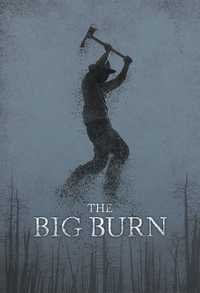Singer: I’m going back to T’Town / To get my women in line /
Yes, I’m goin’ back to T’Town / Just to get my women in line.
James O. Goodwin: Greenwood, growing up, was a very vibrant place, full of life.
Joe R. Burns: And there were 35 or 40 stores from the top of Greenwood until Pine, and they were on each side of the street.
Maxine Cissel Horner: Businesses were booming, people were living well and, of course, we supported one another because we didn’t move out of the community, so the money turned around in the community.
Edward L. Goodwin: There were beer taverns, there were sundry shops, ice cream parlors. There were three or four drug stores. There were beauty parlors, barbershops, hotels, and entertainers.
James Homer Johnson: The whole shootin’ match was there, so anytime you wanted to find out what was goin’ on or who was in Tulsa, all you had to do was be on Greenwood, Thursday night through Saturday night.
James Goodwin: And the spirit was such that on one corner was the Holy Ghost and the other was heroin, not that that is a desired thing. That’s a reality.
Singer: And if you come down to Greenwood tomorrow / I’ll sing these blues some more.
Mr. Burns: And Tulsa was highly segregated then. If you were over on the other side of town, in downtown Tulsa, and you did the wrong thing, a police would stop you and he would tell you in very nasty terms where you could eat and where you could drink and where you couldn’t drink. And then, they had signs up, you know.
No colored could drink at drinking fountains and eat in places. And we stood up — we couldn’t even stand up and eat in Tulsa for a long time, the downtown area. But we didn’t worry about that too much, because in the Greenwood area, we had— we were quite complete. We were unique.
Ossie Davis, Narrator: [voice-over] The story of Greenwood, the black community in Tulsa, Oklahoma, is a story about a people whose forefathers settled the state back in the 19th century. They arrived as slaves to the Indians, as runaway slaves, and as free people. As early as the Civil War, there were over 7,000 black people in the territory.
Currie Ballard: My great-great-grandmother was a slave of the Choctaw Indians. Her name was Charlotte McCoy. She was born in Mississippi. This is her photograph here, and this is her sister, Minerva McCoy. She and her sister were both slaves of the Choctaw Indian named Britt Willis. When they came to Oklahoma after emancipation, after the Civil War was over with, both the two women here married two bothers. They married the McCoy brothers, and my great-great-grandfather, William McCoy, was born in Indian territory in 1839, so he was born essentially 50 years before the great land run, a half a century prior to the opening of central Oklahoma.
Davis: [voice-over] The great land rush of 1889 brought a wave of black settlers and an overwhelming number of whites to the territory. Fed up with racism, blacks saw Oklahoma as a land of freedom and opportunity. Black political leaders aggressively promoted this “promised land,” and by the early 1900s, there were as many as 27 all-black towns. In search of job opportunities, many blacks moved to the larger cities like Tulsa.
Rosa B. Skinner: It was in the fall of the year, and they was talkin’ about Oklahoma, Oklahoma — you could make a livin’ here, you could do so-and-so. And Pop and them thought money’s growing on trees, a-fallin’ off, so he said, “Well, I think I’ll take the kids and we’ll go out.”
Robert Fairchild: And in those days, the oil boom was in existence, and money was flowing freely. People would go to bed at night and wake up the next morning with a gusher in his back yard.
Mr. Johnson: What happened was that the black community, who didn’t receive any benefits directly from the oil fields, began to find employment in the service areas as porters, janitors, elevator operators and the service-related aspect of the businesses relating to oil, so you had employment.
Ms. Skinner: I had two sisters living here, working for white people, living in quarters. And I come up here and they met me and housed me with them and then got me a job working for white people, like they was.
Davis: [voice-over] In 1907, when Oklahoma became a state, the all-white legislative moved quickly to make it a white man’s country. They passed one law after another to keep blacks separate and in their place. Schools, hospitals, business, even telephone booths were to be segregated.
Mr. Johnson: Well, basically in Oklahoma, right after statehood, you had racial bigotry that was out in the open, and I think that this had more to do with helping the development of black townships, because blacks tended to congregate together for their own self-protection.
Davis: [voice-over] In the early 1900s, a group of black businessmen had purchased a small piece land in the northeast section of Tulsa. They called it Greenwood. As segregation practices had grown in white Tulsa, no had the block businesses in Greenwood.
Mabel B. Little: I started a beauty shop, dressing hair, in 1915 in the home. We had money, but we were not able to go and purchase things, so it helped us to go into business for our own selves. And then that’s when the black people began to build.
Mr. Burns: In front of Ramses Drug Store was a cab stand called the Your Cab Company, and there were several cabs and they were all own by black. And some of the owners bought four or five new cabs every year.
Hobart Jarret: Before there were city buses, there were jitneys that black people owned, and the ambulance really intoned as it went through Greenwood Street.
Charles Bate, M.D.: We had two or three ambulances, yes, ambulances which were operated by funeral homes, and there were no fees attached to the ambulance service. Of course, I suppose the undertakers who operated the ambulances felt that the patient might die and they’d get remunerated through that way.
James Goodwin: You’d go into a barbecue place, and you’d hear the blues or you’d hear the jazz, and you’d hear live performance— Dinah Washington and Roy Milton, and the Globetrotters would come strolling down the street.
Edward Goodwin: Earl Bostick was from here. We had Clarence Love was from here — a lot of musicians that went all over the United States. Clarence Love had an all-girls band that traveled all across the country.
Ms. Horner: We had some of the best barbecues that you could ever want to taste. I can remember, though, one place, though, that I guess, to get that white business, he had a side for black folks and a side for white folks. And ? can remember thinking I didn’t think his barbecue was that great, ‘cause I hated the idea that he had to do this. You know, he had a market that he didn’t have to do that.
Davis: [voice-over] By 1921, Tulsa’s black population had grown to almost 11,000, and the Greenwood community was booming — 15 grocery stores, two black movie houses, two black newspapers, four drugstores, two black public schools, a black public library, four barbecue and chili parlors, and about 13 churches.
John Hope Franklin: In Tulsa, Oklahoma, we did have a little separate enclave where blacks had some measure of financial, social, political independence, maybe even some clout.
Mr. Johnson: You had a whole group of black entrepreneurs who came together and formed a kind of union to help develop black businesses.
Mrs. Little: The black business grew so in Tulsa until in 1936, it was announced that we had the largest black business in the whole United States.
Mr. Burns: But when we went on the white side of town, now, you’d have white guys picking at you all the time, and you might get involved in a fight. And the Ku Klux Klans were pretty rampant.
Davis: [voice-over] It was a dangerous time to be black in America. Between 1917 and 1921, racial violence was rampant. In cities across the country, blacks were being beaten, burned and lynched in alarming numbers. In Tulsa, the Ku Klux Klan included political leaders and members of the police. Even local newspapers supported mob violence.
Mr. Johnson: It was always a hostile relationship between the black and white community, and part of it was because the Ku Klux Klan was located in an area just west of the black community itself, on Main and Eastern. This was about four blocks west of where the primary black community was located, and we had to pass by this to go to places of employment and to go to and from school, if we lived in service areas of the quarters. And it was just a hostile situation. There was always a potential for violence there.
Black people were not about to put up with the attitude that the white community was putting before us. The whites felt that they could instill fear in the black community, and blacks wasn’t going for it, and it was a confrontational type of attitude that existed.
Davis: [voice-over] But no one, black or white, was prepared for what happened on the night of May 31, 1921.
Mrs. Little: There was a merchandise store that had one of these old-fashioned elevators that you ran by hand, and some white girl was the operator, and this young man got on the elevator.
Mr. Fairchild: Well, when he went to get on it, he stumbled, and in the effort to keep from falling, he grabbed whatever he could, and of course, the operator was in the way. And she assumed that he was trying to attack her, and she reported it, and he was arrested.
Ms. Skinner: My husband asked to make a speech. He’s the one that predicted that riot. Don’t let nobody fool you. I don’t know who else says they predicted it, but T.R. Davis, the father of my children, he stood up and told the people. He said, “There’s going to be a destruction in Tulsa.”
Mr. Fairchild: And that afternoon, the Tribune carne out and said what had happened, and that they had arrested Dick Roland, “And it looks like there’s going to be a lynching tonight.” And of course, when the Negroes in the community saw this, they says, “Oh, no. No, we’re not going to have that.”
Ms. Skinner: After we went home from church, here come one by the house. “Man, get your guns. Get your guns." Looked like I can hear them lousy people— them loud-mouthed people right now.
Mr. Fairchild: And there they were, hundreds of Negroes standing around, talkin’, using profanity and what-have-you, and shooting their gun every now and then. And then, they felt, “Well, we better get on down to the courthouse.” And they went down to the courthouse, and everybody was just standing around, nobody saying anything to one another. Finally, when a little old white man came up to Barry [?} and said, “Nigger, what you doin’ with that pistol?” He say, “I’m going to use it if I need to.” He said, ‘No, no, you give it to me,” and he tried to take it, and that scuffling set the riot off.
So the Negro decided they were going to make a stand at Cincinnati and ‘Frisco Railroad tracks, but by being outnumbered, they had to leave. And of course, as they left, the white moved in, and as they moved in, they looted, and to hide their behavior pattern, they set fire to the building.
Ms. Skinner: When T.R. woke me up, he said, "Rose,’ he said, “We got to get up and leave here.” He said, “They done started.” And I didn’t want to go. I balked on it. He had to kinda get rough with me before I would leave, but I did leave. And he told to— not to bring nothin’. He said, “Don’t bring nothin’.’ I just had on some barefoot sandals and a towel tied on my head, and that’s the way I went, ‘cause I was fussin’ and disgusted and scared, too.
George D. Monroe: I remember my mother puttin’ us — my sisters and my brother — under the bed. I remember the people comin’ in, white people comin’ into our house with torches, settin’ the curtains on fire and settin’ our house on fire. And one stepped on my finger while I was under the bed, and my sister put her hand over my mouth to keep me from screamin’.
Ms. Skinner: And they was burnin’ and everything. They set houses up there, comin’ this way, burnin’. It reminded me of Sodom and Gomorrah in the Bible. And we was goin’ that way. He said, “Everybody get out in the opening where they’ll see, and won’t nobody get hurt,” and he was right. He was right. Long as we was out where they could see us, they didn’t bother, but they were shooting from airplanes and everywhere. It was a hot time.
Mr. Jarrett: My dad had heard, as other black men in that park had heard, that the white marauders were approaching them. And my dad was joining other black men to protect the black people, the wives and the children who were there. The next thing that I remember was that we saw a railroad train with boxcars attached to it, and in at least two of those boxcars, there were soldiers in uniform, and they were— they were white soldiers.
Ms. Skinner: And they was just like this with them shotguns, just like this. And of course, I just knew everybody goin’ be killed myself
Mrs. Little: We were afraid that they came to kill us, and they said, “No, we came to help you.” And they wanted to take the men and leave the women and children out there. I spoke up. I said, “No, we want to go with our husbands. If you’re going to kill them, kill us all together.”
Davis: [voice-over] During the riot, black men had taken up arms to protect their families. Now, they were charged with incitement, taken off to jail or the county fairgrounds and tagged for identification.
Ms. Skinner: And babies were born that night, two or three babies and everything. I had some personal friends that had a baby born the night before the riot started, and they lost that baby during that riot, tryin’ to keep up with them. They had him in a shoebox— no, in some kind of a box like a shoebox, and that baby got away from ‘em.
Mrs. Little: I never had any feeling — it was such a shock — until I don’t know, that the Lord just strengthened me. But my husband was— he was so tender, and he just broke down. He says, “Baby, we’ve lost everything we had.” 1 said, "But we have each other, honey." I never shed a tear over that. In fact, I never have been angry. I felt sorry for the people that treated our folks like that.
Davis: [voice-over] The Red Cross reported more than 300 people had been killed. Newspapers listed almost 100 deaths, but city officials put the death toll at 36. More than 35 blocks of black Tulsa was burned to the ground. Over 4,000 people were left homeless. Still, most of the people of Greenwood refused to leave.
Mr. Johnson: After they had completely destroyed the black community, blacks then set about to try to rebuild. They could not get building material to build back in Tulsa or the surrounding community. Most blacks had to import the bricks and steel that they rebuilt Tulsa back with, black Tulsa back with, from out of Arkansas and Kansas.
Prof. Franklin: My father had advised his clients and others to build, build with orange crates, build with anything in order to have some shelter. But even so, there are pictures of the winter of 1921-22, of hundreds of tents in which blacks lived, because they were not able to build their buildings.
Mrs. Little: Without any equipment, we moved and built a little shack, and we had to cook outdoors. I remember so well, the rain would come, we’d have to carry our food back in the house, and then after the rain was over, go back and build a fire outside, because you didn’t have— didn’t have gas and had nothin’ to cook on. So it was a bitter pill to swallow.
Prof. Franklin: By the time the National Negro Business League met here in the summer of ‘25, just a few months before we moved to Tulsa, the people who visited here described Tulsa, black Tulsa, as a town with grit, a town that was coming back.
Davis: [voice-over] Out of the ashes, the black people of Tulsa had rebuilt their community, but they needed only to glance across the tracks to be reminded that the racial attitudes of most white Tulsans had not changed.
Mr. Johnson: Well, we played on the brickyard hill on the eastern side. Whites played on the brickyard hill on the western side. Well, we would meet periodically and when we’d meet, we would have us a fight. And it would usually be about “nigger,” and ‘You haven’t got any business up here,” and we felt that we had just as much business as they did.
Ms. Horner: And when you would ride into one of these neighborhoods on your bike and have someone say, you know, "What are you niggers doin’ in this neighborhood?” This is when you really got upset, really got angry, and you had to deal with it. And if you’d go back, you wanted to discuss it, but if you discussed it, you knew you were off grounds and you knew that your parents were going to tear into you because they’d already told you not to go.
Mrs. Little: You’d go into a store and buy a hat. The first thing, the clerk would try it on her head and ask you what you think about it. I mean, my husband was with me, and I wanted to buy a hat, and she says, “but you can’t try it on. Do you want it?” I says, “No. If I can’t try the hat on, I don’t want it.”
Lucille Thompson: I decided I was going to beat them at their own game, so I started to puttin’ tissue in the hat— asking them if I could have some tissue to put in the hat so I could try it on, ‘cause I didn’t have that much grease on my hair, but I thought they would get the point.
Mr. Monroe: I can remember the time when I would go downtown. I was lucky enough to have monies in my pocket. I would go in stores as to where I couldn’t try on a hat. They’d let you know, if you were there, you the last one to be waited on. They’d let you know that they didn’t want your business.
Peaches Little John Wynn: We couldn’t eat when we were downtown, so my mother would always say, “Let’s eat before we go,” if shopping was going to be an all-day trip. I can remember that you could go down to Kress’s and if you went down in the basement, you could stand up at a counter and get something to eat.
Ms. Horner: When I went over to the counter, I was told that 1 had to go to the end of the counter, and that’s— you know, and you see all these places open, and no one there, and you could only be served, and you could not— you could not sit in the seat. You had to stand.
Ms. Skinner: This segregation— when they got where they didn’t want to wait on me, I didn’t pay ‘em no attention. I just left and brought my kids away.
Mr. Monroe: I think sometimes of how nice it would be if that cloak of segregation hadn’t been around me all my life, I might say, to keep me from doin’ some of the things that 1 wanted to do.
Edward Goodwin: Before we had football games, we’d have a parade down Greenwood Street, and there was a lot of pride in people. And they’d just come out on the streets out of those businesses and there would that be throngs of people.
Mable Rice: It was high spirits in the community. Many, many droves of people came down to see the parade. Kids looked forward to it. We started at old Booker T. Washington High School and marched to Carver—down Greenwood to Carver — and that’s where the football games were played, at Carver Stadium.
I remember, during the war, Booker T. had— we made a big bomber on the field with the band members, and we, as small majorettes, we twirled and we were the propellers of this bomber. And we started out— they turned all the lights out, and we had lights in our hands. And we started out on the ground, stooped on the ground, and as we marched, we took off, and it looked like the bomber was taking off on the field.
Ms. Wynn: I always wanted to be a majorette, you know, and be in that parade, but I do remember when I got to Carver, I did have a friend that— her sister had been a majorette and she was a majorette and so we got together and we like begged the band director to let us be part of the parade, and so we were majorette. 1 got to march in one parade.
Edward Goodwin: My experience at Booker T. was one that 1 wouldn’t trade for anything in the world. We had dedicated teachers. We had teachers that were legends. We had this rich heritage at Washington, and these teachers, they didn’t change. You’d hear about ‘em, you know, from the second grade. You’d hear about Seymour Williams, and then he taught you, you know, l2 years later, and that was a long time to a kid, and it was an ongoing tradition.
Mr. Burns: I remember Horace Hughes, one of the finest English teachers that you could have anywhere. He was black. I’ve seen him come into that classroom and walk down to the back of the room and then just start pointing out guys and asking them to quote from Shakespeare. We were all given 150 lines of poetry to learn. We were all given about 25 or 30 quotations from Shakespeare and Byron and all— Keates and all the— Shelley and the rest of ‘em. And if he asked you the line, he’d just quote the first line and you’d have to come up and give him the next line and finish the quotation. And I can quote ‘em now. That’s how good they were — like the poetry of Brutus, “lies not in the stare, but in ourselves, that we are underlings” — Shakespeare. That’s the way Horace wanted you to do, you know.
Ms. Horner: 1 don’t remember anyone coming out of high school that could not read, and I remember many high school graduates took that high school graduate certificate from Booker T. Washington High School and ran with it. They could compete and do anything, and they did well.
Bertha A. McIntyre: When I was in school at old Booker T., we did not have Negro history textbooks. Two of our instructors, A.J. Lee and Bess Roberts, had to come up with a textbook for us to use so that we could find out about ourselves.
Prof. Franklin: As long as I was at Booker T. Washington High School, and as long as people were telling us that we were doing all right and that everything was fine, beautiful, and wonderful, then I felt that it was. But on one occasion, when we needed a pipe organ, I believe, to use in some musical rendition that we were offering, we planned to have a program— the program at Central High School, and we were given permission to do it.
Central High School was an imposing structure, a city block long, a city block wide. It covers an entire city block. And I said, “So this is what they have, compared to what I have,” and I realized then that they were keeping me out of an opportunity that was really, from my point of view, not only mean-spirited, but bigoted.
Ms. Rice: The first thing I can remember, the evening that the war broke out, or the news came over the radio, I remember my mother saying, “We are at war.” And I said, “What does that mean?” And she said, “Well, America is involved in a war.” And in my mind, I thought it meant that the war would be on Greenwood the next day. I was seven years old, and I thought it would be there. And I can remember packing my dolls suitcase, made peanut butter sandwiches and packed a suitcase, because all I knew about war was that people starved.
Mr. Burns: During World War II, after we got in Australia— we landed there — it took us 21 days to get over there — and every two or three days, we’d have one of the white officers— this was when they had the black and white army. All of the enlisted men and non-coms were black, and the white— the officers were all white. It’s what we called the two armies. And they would have these sessions and tell us, “Now, we’re going into an all-white country" — Australia was known as all-white country — “If they want you to go to the back door to be served, now don’t get excited about it. Just go on to the back door. We came down here as their friends. We don’t want to come down here and tell them how to operate.” So we just listened.
All the white officers went out and made these speeches and whatever they said to them, these white Australians came back and told us that the white officers had told them that we had tails, that we were inclined to be violent, and we carried knives and guns and would hurt come of their kids — anything to keep them afraid of us. But it didn’t work.
When I come back to Tulsa after spending 32 months in the Pacific with General MacArthur, I had gone from a staff sergeant to a first lieutenant. But when I got down to Fort Smith, Arkansas, they wanted me to be segregated from the other white officers and white enlisted men in the group, so we went along with it, ‘cause I was on my way back to Tulsa to meet my wife, and I didn’t have time to fight segregation. But once I got back to Tulsa, I made up my mind that I was going to take it on wherever I found it, and I would going to whip it wherever I found it, and that’s what I did.
Ms. Rice: It was after that time that I began to question it, because I knew that these men had been over fighting for freedom, supposedly. It began to open my eyes to paying attention to things like riding in the back of the bus. I began to wonder why. Why couldn’t we eat in Kress’s? Why did we have to go down on one end of the counter and not sit?
Mr. Johnson: I only started questioning after I heard a lecture at Howard University. The question come up, well, I pay the same thing to ride the train, I pay the same thing to ride the bus. Why is it that 1 have to ride in the back of the bus? Why is it that I have to find a restroom— if there’s no restroom in a small bus station, why do 1 have to find the bushes or try to find a place where colored can use the restroom? It wasn’t until at that juncture that I start to question, “Why does this exist?”
Davis: [voice-over] After the war — in Tulsa and across the country — white Americans were being challenged to end segregation. Ever so slowly, doors were being forced open in education and in business.
Mr. Burns: I was pretty happy about becoming the first black clerk in the Tulsa Post Office. When I walked in, an old boy named— white boy named Steve Metheny, he came over to me, he says, “What’s your purpose?” I said, "I came down here to be— go to work for the Post Office as a clerk.” He said, “We don’t hire black clerks. We only hire black carriers.” 1 said, “Well, I’m coming in as a clerk. I’ll just wait until the postmaster comes down, and he’ll tell you.”
So I sat over there, and a few minutes later, the postmaster came in. He came right over to me and shook my hand and says, “Hello, Joe. Glad to see you.” And he walked me over to Steve Metheny and said, “This is Joe Burns and he’s going to be our first black clerk, so put him on and make him a regular.”
Mr. Johnson: Prior to 1955, there was never a black street cleaning crew that worked in an area outside of the black community, but around this particular period of time, an all-black crew was assigned to work in an area east of Lewis which was all white. And I was a part of that crew, and while we had some good moments, there were lots of hostile moments that existed during this particular period of time, where we were accused of everything from molesting white women to making obscene gestures, of which none of these ever proven to have any validity.
Ms. Wynn: When I made the decision to go to Central, we did not want to tell anyone that I was going, and the reason being was we did not want to cause any confusion, commotion or any problems with me going there, like news media being involved. I had a chemistry teacher that, every time I went in class during that first week and the first few weeks of school, he would make reference to, “Oh, you’re from Little Rock, aren’t you?" And I would say, “No, I’m not from Little Rock." And it was sort of like— I felt I had been accepted, and he was making a point of, “Here’s a black person in this classroom,” and by saying Little Rock, here’s a— Little Rock had trouble with integration and just referring to that was bringing up something that was negative.
Ms. Horner: I can remember a funny story about my son when we marched here in Tulsa. And we were— you were boycotting different restaurants, and at that time, there was a Borden’s up in-out on 36th Street North. It was located at that time— it was the first shopping center. It was called Northland Shopping Center.
And my son told me — he was small — and we used to stand outside Borden’s and, you know, going to do the boycott, and we finally got a chance to eat in there. And we went through this line, and we got to the table and all, and he said, “Is this what we were marching and boycotting for?” And I said, ‘Well, the right to be able to go anywhere you want to and eat where you”— he said, “These potatoes are awful. I don’t even know why you want to come here.”
Prof. Franklin: When I was teaching at a state school— state college in North Carolina, one of the distinguished professors at Duke asked me if it was true that I was opposed to segregation. I said yes. He said, “But I don’t understand how you would be opposed, because if you’re successful in opposing segregation, that means that your school will close and you won’t have a job." That always enters into the minds of people who have this view that there’s nothing good in the black community and everything is good in the white community. And as long as you have that kind of evil, disjointed, distorted view of life where all the good is on one side and all the evil is on another, then you can’t have a healthy integration.
Davis: [voice-over] Ironically, Greenwood, which had been built in the face of racial hatred, which had survived total destruction, would not survive integration.
James Goodwin: With the onset of integration, many of the kids of the owners or the business people left Tulsa, going to Chicago, California, New York, Denver in search of their own new life, a new life altogether.
Ms. Rice: I think we began to drive around the Greenwood area, and go straight into South Tulsa for— so I can remember there were long periods of times that I didn’t go into Greenwood area at all, because I can remember how surprised I was at how much it had deteriorated when I began working again in the Greenwood area.
Ms. Horner: And you’d see the businesses deteriorating because we were not supporting the businesses, And then the older folks were giving it up, you know, or they were shifting to other parts of the city.
Mr. Burns: Integration helped to kill Greenwood, and of course, when they began to redesign the expressways — like they do most of the time in these cities throughout the United States — they always engineered in such a way that the expressways come across the main section of the black community.
Prof. Franklin: The same thing happened to Tulsa, the Tulsa black community that happened to the Nashville, Tennessee black community, that happened to the Raleigh-Durham, North Carolina black community, that happened to the New Orleans, Louisiana black community. Here come the interstates roaring right through the black community and playing— wreaking havoc with them, destroying the streets, destroying the business establishments, and they never fully recovered. They never fully recovered.
Mr. Jarrett: Greenwood was one was place that I had lived on which gave me a sense of communal relationship with the uppers and the lowers and the middles, and it all just blended in together.
Ms. Rice: All up and down the street, the there people that knew who we were and they knew what we were supposed to be doing and what we were not supposed to be doing.
Ms. Horner: We had good role models, good people who were training and teaching us in our community.
Edward Goodwin: I wish some of these children could experience what we experienced, this thing of living together and depending on each other, and the brotherhood that we had.
Mr. Burns: They’d always tell us that the opportunity’s going to come down the road. Don’t worry about ‘em, because they would show up.
Prof. Franklin: There was a sense of self-respect and self- esteem and the feeling that our color didn’t have anything to do with our not being as good as anyone else.
Mrs. Little: Segregation made black folk take care of themselves, be independent, have their own business, train their children, build their colleges, build their schools, build their homes. Integration separated.
James Goodwin: I don’t think racial segregation is a good thing from the American experience, so in that sense, no, we’re not better off. But the quality of our lives, in many respects, was better in the days of segregation, and the challenge today is to make it as good or better.
Singer: If you come down to Greenwood tomorrow / Well, I’ll sing these blues some more.
Dr. Bate: I like to tell the story of someone coming to my office paying $2 and my going down to the Busy Bee cafe and eating and paying 90 cents, and then the girl at the Busy Bee going over to McGarry’s and buying some hose, McGarry’s going to Bowser’s Prescription Pharmacy and buying come aspirin; Bower’s going down to McKay’s and getting his pants pressed; the man from there going over to the black dentist — all within 1-1/2-block area. A dollar perhaps turned over 12 or 13 times in that area.
But now, through integration, everything is gone from the black area. We have nothing there. You can’t get a spool of thread there anymore. So we got integration and suffocation and degradation [sic] and all the other “gations” you would like to have had.
